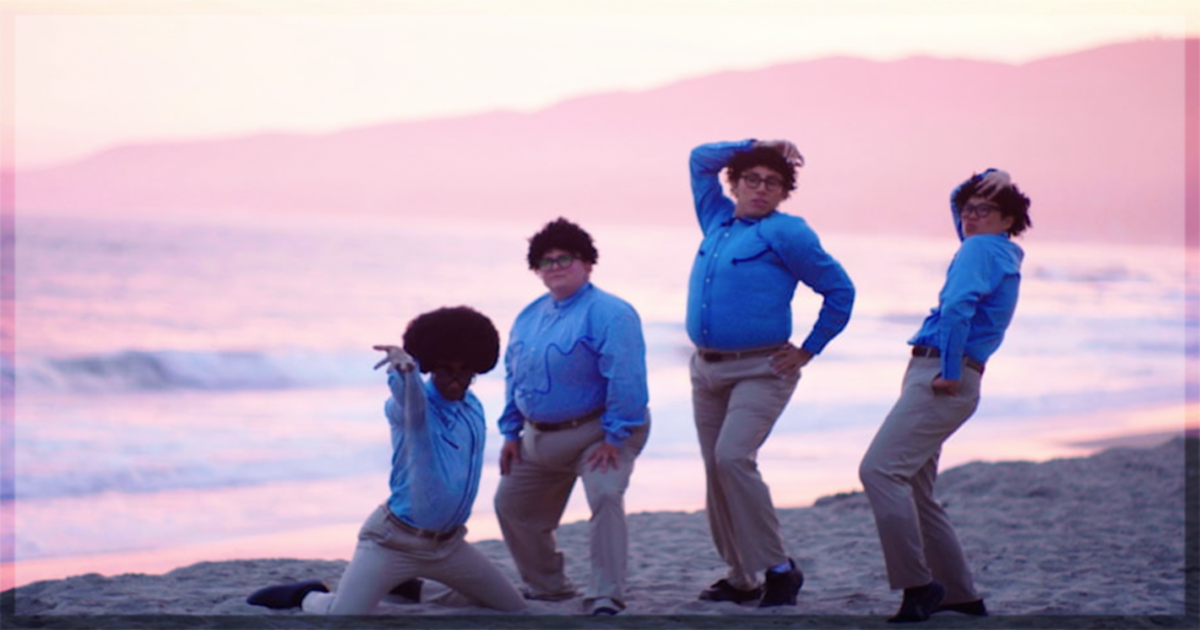Nearly six minutes into We Are Pat, a hybrid documentary from Tribeca alum Rowan Haber, our gaze fixates on a graphic in pink and blue gradient featuring a photograph of the director’s toddler self—naked, sporting a cute red eyewear, and waving their hand—juxtaposed with a larger photograph of Pat, the divisive androgynous character from the ‘90s Saturday Night Live cult sketch “It’s Pat,” who’s also waving their hand and seen in a fat suit, a light blue Western shirt, oversized heavy-framed glasses, and a curled black wig. Succeeded by the title card, it’s a striking image that recurs towards the movie’s endnote and reflects its emotional throughline.
Pat, created and played by SNL cast member Julia Sweeney who appeared in several sketches from 1990 through 1994, beginning with “Pat at the Office,” has been a decades-long obsession for Haber, who keeps revisiting its 1994 spin-off movie of the same name, whose initial draft was co-written by Quentin Tarantino, and whose final result was chiefly met with recoil from critics and audiences alike. Haber, who acts as the film’s intermittent narrator, is trying to make sense of the controversial character through their own gender journey. “I still laughed my ass off,” the filmmaker delivers in a voiceover that precedes the aforementioned graphic. “But this time, I saw something totally different. I saw me.”
It is this fixation that propels the trans director to reclaim and reframe the fraught legacy of the cult figure via today’s politics and the trans and nonbinary gaze. Haber then proceeds to gather a slew of trans and gender non-conforming comics, including the likes of Murray Hill, Brontez Purnell, Robin Tran, Nori Reed, Esther Fallick, and Roz Hernandez. Together, they form a “writers’ room” bent on reanimating Pat from the grave, with input from Sweeney herself. The documentary largely functions as a mapping of Pat’s cultural impact and how it gets eroded over time, motored by interviews with said trans comedians, alongside historian Jules Gill-Peterson and television studies professor Karam Ahn, as well with SNL alums Kevin Nealon and Molly Kearney, the only nonbinary actor who’s been part of the sketch comedy’s core cast. For most of them, Pat wasn’t just a source of humor but also of personal liberation, particularly in a time when anxieties around gender and sexuality were so heightened, as with today’s sensibilities, wherein transphobia remains at the center of culture wars and dehumanizing legislation. And while the character is touted by some as a trailblazer and “nonbinary before nonbinary was cool,” dissenting opinions also point out that Pat is a transphobic cliché that indulges the normative audience, as the sketches are primarily concerned with figuring out, if trivializing, Pat’s gender. At the same time, Pat is seen as a terrible example for the neurodivergent community, given how Sweeney’s writing leans on disability tropes. In this way, Pat is both a character of and past their time.
In her house, Sweeney displays a collection of paintings, photographs, religious totems and figurines, and headpieces that seem to convey transness and bend the normative notion of gender. It is an extension of her penchant for “the performance of gender,” which is the whole deal of the sketches featuring Pat. Though she didn’t intend for Pat to be an onscreen representation of androgyny, she inevitably falls into that aspect when a joke about the ambiguity of the character’s gender prompted rapturous reactions from the SNL audience. Soon, 13 million people tuned in to watch the sketches. Magazine covers and features instantly followed. People began to dress as Pat. Merch shirts, mugs, and holiday cards were easily sold out. Pat was a major breakthrough for Sweeney just as it was a response to the gender disparity within SNL, which included ten male cast members, such as Phil Hartman and Mike Myers, and only three women. That Sweeney got her shot at the spotlight via an ambiguously looking and presenting character wasn’t by accident, as female characters were often written and even played by male actors at the time.
Though the movie still defaults to a talking-head style, it is visually rich, hyperactive, and even a little disorienting because of how Haber so effectively harnesses mixed media lexicon—from VHS or archived footage to animation, to collages of old photographs and various cut-outs, to news clips, and to text overlays—steeping We Are Pat in a kind of campy, DIY aesthetic, paralleled by Erick del Aguila’s scoring that is chiefly upbeat and propulsive. Past this, editor Hannah Buck, who shares screenwriting credit with Haber, cuts between a variety of footage and images in a way that helps feed the movie’s back-and-forth momentum, as though we’re rewinding a television show ad infinitum.
Whereas the actual results of the reimagined sketches of Pat aren’t exactly funny or powerful, the documentary finds a more intriguing theme in how “It’s Pat” operates in a broader tradition of trans comedy, and how it’s evolved from the vaudeville culture to drag, to the Harlem ballroom scene, and to stand-up comedy. “The history of trans people is the history of trans comedy,” says comic Shadi Petosky, emphasizing how the trans community, through humor, has created a lexicon for survival in a world built against us. Perhaps that could have been the narrative focus instead of the repurposing of the original sketches, as several Pats, who have more agency and bodily autonomy, now exist beyond the limiting world of SNL, beyond the imagination that Sweeney could afford us.
It is so common for trans and gender non-conforming people to look at cis work and bend it in a way that makes sense to us. It’s nearly become a habit for us to project trans and queer thought onto every piece of art and media that we consume, precisely because of the dearth of reference points that truly reflect our lived experiences. To me, what the documentary actually reclaims is not the legacy of Pat, but the means of production that trans and gender non-conforming people have long been deprived of; that it is possible to take our narratives into our own hands. That said, I long for a version of our beautiful trans lives that no longer needs Pat.
We Are Pat recently played at the Tribeca Film Festival.
Learn more about the film at the Tribeca site for the title.


